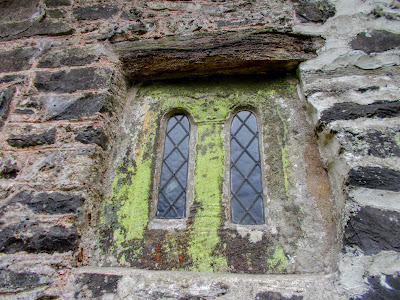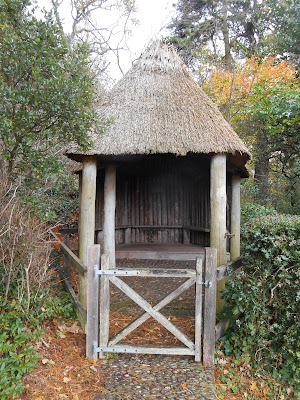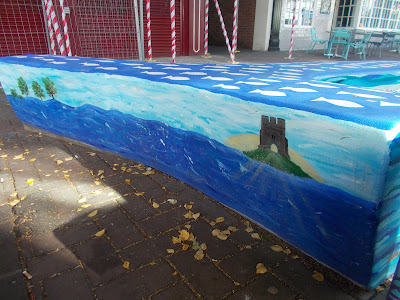Most but not all of the following seats are in memory of an individual or a group of people. As I come across them, I will add more photos to this post.
Oak Leaf Seat in Combe Hollow near Compton Dundon
A plaque on the rear of this oak leaf seat says "This
seat has been sculpted in memory of Anthony Clothier, a forester of
great vision, who enjoyed managing woodland for future generations to
enjoy. Sponsored by friends and members of the Royal Forestry Society."
Grid reference ST 500 329.
St Leonard's Churchyard, Butleigh
This seat in the graveyard of St Leonard's Church at Butleigh is one of my favourites. The base is a fallen or felled coniferous tree, which must have been very tall, judging by its considerable girth. The back of each seat has a carving on it:
- St Leonard 2012,
- The Olympic rings,
- The Paralympic symbol
- A crown and 1952-2012 commemorating the Queen's Diamond Jubilee
There are carved animals at each of the four corners:
- A squirrel
- A fish
- An owl
- A Rabbit
On the top of the seat are two lambs, one seated and one standing.
St Leonard's Churchyard, Butleigh
Two lambs on the top of Butleigh Church's seat
Carved Squirrel on the Butleigh Church Seat
Wind and Weather Hut, Selworthy
The Memorial Hut on Selworthy Beacon (grid reference SS 915
476) is also sometimes known as the Wind and Weather Hut. It is a stone
built shelter, erected in 1878 and built as a memorial to Sir Thomas
Dyke Acland 10th Baronet (1787-1871) by his
youngest son, John Barton Arundel Acland of Holnicote, New Zealand.
Jubilee Hut, Webber's Post
The original hut was constructed to commemorate Queen Victoria's Diamond Jubilee in 1897. It is designed so that whatever way the wind is blowing, there should always be a sheltered side.
Pilton Tithe Barn
This seat commemorates the Women's Land Army 1914-18 and 1939-45
Grid reference ST 589 407
Pentley Seat, Ley Hill above Horner
The seat was erected by his
wife in honour of Charles Thomas Dyke Acland 12th Baronet, who died in 1919. The
Acland family owned the Holnicote Estate, which included the Ley Hill from the mid-18th century until 1944 when it was donated to the National Trust by Sir Richard Dyke Acland, 15th Baronet.
Kingston St Mary's Millennium Seat
The panels on the hexagonal seat
on the village's small green depict the history of Kingston St Mary,
including the wool trade, which provided money to build the church, general farming, the Kingston Black cider apple, Quantock wildlife and the future as envisaged by local school children.
Mitcham Seat, Allerford
View across the Vale of Porlock from the Mitcham Seat
Lady Lydia Hoare married Thomas Dyke Acland (the 10th Baronet), whose family owned the Holnicote Estate, in 1808. She grew up in Mitcham in Surrey where there was a similar seat. This one is located on a permissive path between Allerford and Selworthy (grid reference SS 910 467). Lydia and Thomas had 10 children.
Carved wooden seat at Hawkridge on Exmoor
There is a large buzzard? on the right hand side and a small red deer stag on the left.
Man on Bench, Bruton
This bronze sculpture was designed by Giles Penny and installed close to the packhorse bridge in Bruton in June 2015. Apparently it cost £22,000 and gets very hot in the summer when the sun shines, so if you choose to sit down on it on a hot day, beware!
Churchyard of Holy Cross Church, Middlezoy
Date and initials on the Middlezoy seat
This seat with carved stone ends is located in the churchyard of Holy Cross Church in Middlezoy. Judging by the date and initials on the back, it was made by more than one person in 2016. It is decorated with various wild animals, including a bat, a fox, a rabbit, an owl, a hedgehog and various birds.
Apple seat, King George V Playing Field, Trull
This seat at one side of the King George V Playing Field in Trull near Taunton is supposed to look like an apple, although I think it looks more like an alien spider!
Stone seat on Wavering Down
This stone seat has the words "Only a hill, but all of life to me" carved into the front of it. This is a quotation from a poem by Geoffrey Winthrop Young (1876-1958), who was a British climber, poet, educator and author. The rest of the poem is as follows:
Only a hill: earth set a little higher
above the face of Earth: a larger view
of little fields and roads: a little nigher
to clouds and silence: what is that to you?
Only a hill; but all of life to me,
up there between the sunset and the sea.
Seat in Ashbrittle Churchyard,
which features the ancient yew tree in the same churchyard
Millennium Seat near Chipstable
Bespoke seat in memory of Ann Le Bas 1923-2020, Winsford
Presumably she liked cricket and attended the church in Winsford, as these are the decorations under the armrests. She was a painter and printmaker, who lived and worked in Winsford.
Queen Elizabeth II's Platinum Jubilee seat, Somerton
Deer, sheep, badgers, a heron and a bird of prey are depicted on it
High Street, Taunton
High Street, Taunton
High Street, Taunton - Glastonbury Tor
These concrete seats were painted by GoCreate and Rights Community Action in 2023 to raise awareness of climate change.
High Street, Taunton - flowers
Watchet Boat Museum
These benches were painted by Alison Jacobs, who is a local artist.
East Quay, Watchet
East Quay, Watchet





























































